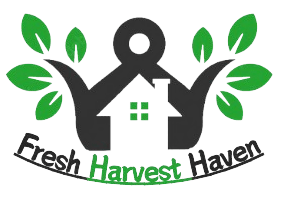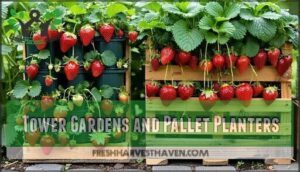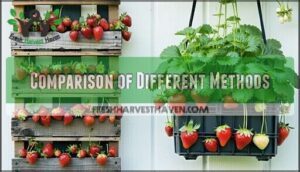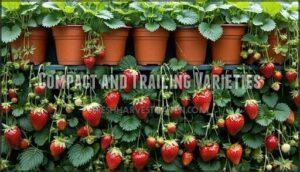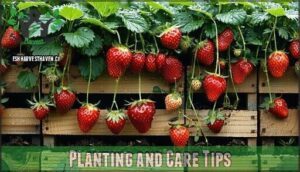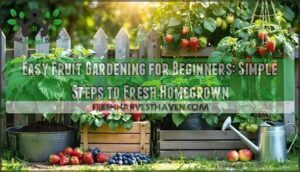This site is supported by our readers. We may earn a commission, at no cost to you, if you purchase through links.

These methods triple your yield compared to ground planting while using minimal space. Choose day-neutral varieties like ‘Seascape’ or ‘Albion’ for continuous production.
Use well-draining potting mix and water consistently since vertical systems dry out faster. Position your setup in areas receiving 6-8 hours of sunlight daily.
Strawberry towers work best for beginners, while hanging baskets suit trailing varieties perfectly. The key lies in proper spacing, regular feeding, and strategic runner management to keep plants productive throughout the growing season.
Table Of Contents
- Key Takeaways
- Vertical Strawberry Benefits
- Choosing Right Planter
- Selecting Strawberry Variety
- Planting and Care Tips
- Vertical Gardening Structures
- Harvesting and Maintenance
- Frequently Asked Questions (FAQs)
- How to grow strawberries vertically?
- Can you grow strawberries in a vertical planter?
- Can you grow white strawberries in a vertical garden?
- How do I choose the best strawberry varieties for vertical gardens?
- Can you harvest strawberries from a vertical garden?
- How do you grow strawberries in a garden?
- Do strawberries grow well vertically?
- How tall should a raised bed be for strawberries?
- What do coffee grounds do for strawberry plants?
- What not to do when growing strawberries?
- Conclusion
Key Takeaways
- You can triple your strawberry yield in minimal space by using vertical systems like towers, hanging baskets, or wall planters.
- Choose day-neutral varieties such as ‘Seascape’ or ‘Albion’ for continuous harvests throughout the growing season.
- Make sure you use well-draining potting mix, water consistently, and position your setup in a spot with 6-8 hours of sunlight daily.
- Regularly prune runners, feed your plants, and check for pests to keep your vertical strawberries healthy and productive.
Vertical Strawberry Benefits
Growing strawberries vertically transforms your limited garden space into a productive berry paradise that can yield over 25 plants in just a 2-foot area.
Transform tiny spaces into berry-producing powerhouses with vertical strawberry gardens.
You’ll discover that vertical systems offer superior drainage, better air circulation, and protection from ground pests while making harvesting a breeze without the back-breaking work of traditional ground-level gardening, providing an overall easier experience with better air circulation.
Space Saving Advantages
If you’ve ever dreamed of fresh berries but only have a balcony or a tiny patio, vertical strawberry gardening is your secret weapon.
By thinking upward, not outward, you can Maximize Yields in a Small Footprint, perfect for Urban Gardening.
Here’s how vertical strawberries turn compact space into a berry haven:
- Grows 3–4 times more plants per square foot
- Ideal for Balcony Gardens and patios
- Uses Vertical Expansion to save ground space
- Creates small space strawberries anywhere
- Delivers lush, productive displays
Easy Harvesting and Maintenance
Convenience defines vertical strawberry gardening. You’ll reach every plant without bending or kneeling, making harvesting and pruning simple tasks.
The elevated design improves pest control by reducing ground-dwelling insects. Excellent drainage prevents root rot while direct access streamlines watering and fertilizing routines.
| Maintenance Task | Traditional Beds | Vertical Systems |
|---|---|---|
| Harvesting Techniques | Requires bending/kneeling | Eye-level access |
| Pruning Methods | Ground-level work | Standing height |
| Pest Control | Soil-based issues | Elevated protection |
| Soil Health | Ground compaction | Controlled drainage |
Increased Yields and Productivity
Beyond making your garden management simpler, vertical strawberries deliver impressive yields that’ll surprise you.
Smart Plant Density optimization lets you pack more plants into smaller spaces, while Optimizing Sunlight exposure guarantees each berry develops fully.
Everbearing varieties and dayneutral varieties keep your harvest rolling from spring through fall.
Maximize your strawberry harvest with vertical gardening—double the yield in half the space for a productive and efficient berry patch!
- Harvest up to 25 plants in just 2 square feet of space
- Boost yields through strategic Runner Control and pruning
- Enhance Pollination Strategies with accessible flower positioning
- Apply targeted Nutrient Management for bigger berries
- Maintain continuous production with proper variety selection
Choosing Right Planter
Selecting the right vertical planter determines your strawberry garden’s success and productivity.
You’ll need to take into account factors like space constraints, sunlight exposure, drainage requirements, and your budget when choosing between hanging baskets, tower systems, or DIY options.
Hanging Baskets and Wall Mounts
If you’re looking to maximize space and add a touch of charm, hanging baskets and wall-mounted planters fit the bill.
These vertical strawberry planters keep your berries off the ground, making pests less of a headache. Choose Basket Materials like sturdy plastic or wire with coco liners for good drainage.
Secure wall mounts firmly, and make sure your plants get at least six hours of sunlight. Hanging strawberry plants dry out fast, so use smart Irrigation Methods.
You can find various basket options online. Pair with herbs for Space Optimization and Aesthetic Appeal, blending practicality with vertical gardening style.
Tower Gardens and Pallet Planters
Space Optimization reaches new heights with strawberry tower gardens and pallet planters.
DIY Pallets transform into multi-level growing systems, while Hydroponic Towers maximize vertical gardening potential in small spaces.
Material Selection matters—choose weather-resistant wood or PVC for durability.
These vertical strawberry planters create impressive strawberry tower garden setups with excellent Aesthetic Appeal.
You’ll fit multiple plants in minimal floor space while maintaining easy access for care and harvesting.
Consider purchasing a complete tower system for ease of setup.
Comparison of Different Methods
When choosing between vertical strawberry planters, Cost Analysis reveals DIY strawberry towers cost 60% less than commercial systems.
Material Durability varies substantially—wooden towers provide thermal insulation while PVC offers lightweight portability.
Space Efficiency differs too: wall-mounted planters support 400% greater density than hanging baskets.
Aesthetic Appeal ranges from rustic wooden designs to sleek stackable systems.
Maintenance Needs also vary considerably across different vertical strawberry system options for your strawberry vertical garden.
DIY and Repurposed Planters
Creative minds can transform everyday items into productive DIY strawberry towers.
You’ll find PVC pipe and rain gutters make excellent vertical strawberry planter ideas for budget-conscious growers.
Pallet projects create rustic charm while stacked pots offer modular flexibility.
Hanging baskets work perfectly for cascading varieties.
These DIY projects using PVC towers and gutter systems deliver professional results at fraction of commercial costs.
Selecting Strawberry Variety
Choosing the right strawberry variety makes the difference between a mediocre harvest and baskets full of sweet, juicy berries from your vertical garden.
Day-neutral varieties like ‘Seascape‘ and ‘Albion‘ work best for containers because they produce fruit continuously throughout the growing season, regardless of day length or temperature changes.
Day-Neutral and Everbearing Varieties
Day-neutral and everbearing strawberry varieties excel in vertical strawberry planters, offering continuous production throughout the growing season.
Day-neutral varieties like ‘Seascape’ and ‘Albion’ provide consistent flavor profiles with excellent climate adaptability, making them ideal beginner options.
These vertical strawberries produce fruit within three months, while everbearing types deliver two main harvest waves for maximum yields.
Compact and Trailing Varieties
Compact varieties fit perfectly in vertical strawberries setups where small spaces demand efficiency.
These small-space cultivars pack serious production into tiny footprints, while trailing strawberry types cascade beautifully from hanging planters.
Trailing varieties like ‘Temptation’ and ‘Tristar’ excel as best container varieties for towers and hanging basket strawberries.
Key benefits of compact growth varieties:
- Maximize fruit production in minimal square footage
- Adapt well to limited sunlight options compared to larger plants
- Require less pruning and maintenance than sprawling types
Disease-Resistant and Climate-Adapted Varieties
Regional Adaptation matters when selecting strawberry varieties for your vertical garden.
Disease-resistant cultivars like ‘Seascape’ and ‘Albion’ reduce fungicide use by 70% while resisting Verticillium wilt and root rots.
These climate-adapted varieties handle temperature swings from 35°F to 85°F, ensuring pest resilience and consistent fruit production in challenging growing conditions.
Flavor Profile and Size Considerations
Beyond disease resistance, strawberry varieties offer distinct flavors and sizes that’ll shape your harvest experience.
Sweet berries like ‘Seascape’ deliver dessert-quality fruit, while others balance sweetness with tartness perfect for preserves.
Consider these flavor and size factors:
- Berry Sweetness: Dayneutral varieties like ‘Albion’ produce consistently sweet berries throughout the season
- Pineberry Taste: White strawberries offer unique strawberry-pineapple flavors that surprise guests
- Berry Size: Everbearing strawberries typically produce medium-sized fruit ideal for snacking
- Varietal Flavors: Some varieties lean tart, others intensely sweet—match your preferences
- Yield Expectations: Compact varieties sacrifice size for quantity, maximizing vertical space efficiency
To guarantee peak flavor, consider that optimal harvest occurs in the early morning.
Planting and Care Tips
Once you’ve chosen your strawberry variety and planter, proper care guarantees your vertical garden thrives and produces abundant fruit.
The right soil mix, consistent watering schedule, and regular pruning will keep your plants healthy and productive throughout the growing season, ensuring your vertical garden is productive.
Soil and Compost Requirements
Once you’ve picked the perfect strawberry variety, it’s time to focus on soil and compost requirements.
Start with a lightweight organic potting mix, making sure the soil pH sits between 5.5 and 6.5.
Mix in well-rotted compost to boost organic matter and nutrient balance, and add about 20% perlite for soil drainage.
Peat moss helps hold moisture, but balance it with compost for soil fertility, and aim for enough soil volume to support strong roots.
Consider using a specialized strawberry mix for ideal growth.
Watering and Fertilization Schedules
Your strawberry tower’s thirsty roots need consistent care to produce sweet berries. Watering Frequency varies by planter type—hanging baskets need daily attention while stackable towers require water every 2-4 days.
Fertilizer Types should shift from balanced formulas during growth to high-potassium blends during fruiting season. Consider selecting <strong>June-bearing varieties</strong> for one large crop.
- Check soil moisture by inserting your finger one inch deep into the growing medium
- Apply water-soluble fertilizing every 2-3 weeks to maintain proper nutrient balance in containers
- Watch for Deficiency Symptoms like yellowing leaves or poor fruit development requiring Seasonal Adjustments
Pruning and Training Techniques
After getting your watering and feeding routines down, focus on pruning and training for thriving vertical strawberry planters.
Here’s a precise approach:
- Runner Removal: Snip runners and stolons so energy feeds fruit, not suckers.
- Blossom Pinching: Remove early flowers for stronger roots.
- Leaf Trimming: Prune dead or crowded leaves for airflow.
- Vertical Support: Guide runners upward for even sunlight and easy picking.
For airflow and sunlight, summer pruning manages canopy.
Vertical Gardening Structures
When choosing your vertical strawberry system, you’ll find options ranging from simple DIY towers to sophisticated commercial planters that can transform any small space into a productive berry garden.
These structures include PVC pipe towers, wooden frame systems, stackable planters like GreenStalk units, and wall-mounted pockets that maximize your growing potential while fitting your budget and space constraints.
They can help maximize your growing potential, and by choosing the right system, you can ensure that it fits your budget and space constraints.
PVC and Wooden Strawberry Towers
PVC pipe offers budget-friendly tower construction with excellent PVC durability for growing strawberries vertically.
These lightweight vertical strawberry containers cost less and relocate easily.
Wooden aesthetics provide sturdier vertical strawberry planters with natural appeal but higher cost comparison.
Both design variations create efficient vertical strawberries systems.
PVC suits beginners wanting affordable options, while wood appeals to gardeners prioritizing appearance and longevity in their vertical strawberry container setup.
Strawberry Raised Garden Stacks
Raised garden stacks transform vertical strawberry farming into an organized system that maximizes your growing potential.
These stackable pots create multiple growing levels while maintaining excellent drainage solutions and proper soil volume distribution.
Stack assembly becomes straightforward with interlocking designs that secure each level.
Tier capacity typically ranges from 3-7 levels, accommodating 15-42 plants depending on your chosen strawberry planter configuration.
Rotation methods assure even sun exposure across all tiers.
These systems also promote better airflow and plant health.
Here’s what makes stacked systems shine:
- Modular design – Add or remove tiers based on space needs
- Built-in reservoirs – Water flows naturally through each level
- Compact footprint – Fits in just 2 square feet of space
- Easy maintenance – Individual tiers lift out for cleaning
These vertical planters keep roots healthy while simplifying your vertical gardening routine.
GreenStalk and Stackable Planters
Moving from garden stacks, GreenStalk and stackable pots take vertical strawberry gardening to the next level.
These vertical planters make life easier with:
- Stackable Advantages—grow up to 30 plants in just 2 square feet.
- GreenStalk Features—UV-resistant, food-grade plastic.
- Tier Capacity—holds 40 gallons of soil.
- Assembly Simplicity—quick setup, no tools.
- Smart watering—reduces water waste.
These systems are often recommended for organic gardening due to their efficiency.
Hanging Planters and Wall Pockets
Against all odds with hanging planters, you’ll maximize space while growing strawberries vertically.
Wall Pocket Materials like breathable fabric offer superior drainage compared to plastic options. Hanging Basket Types range from coconut fiber to modern resin designs.
DIY Wall Pockets using repurposed materials save money while providing custom sizing. Strategic Irrigation Strategies prevent overwatering in suspended systems.
Consider Aesthetic Considerations to complement your outdoor space beautifully.
| Feature | Best Choice |
|---|---|
| Wall Pocket Materials | Breathable Fabric |
| Hanging Basket Types | Coconut Fiber Lined |
| DIY Wall Pockets | Repurposed Containers |
| Irrigation Strategies | Drip System Setup |
Harvesting and Maintenance
You’ll know your vertical strawberry garden is thriving when those bright red berries appear, but proper harvesting and ongoing care determine your success throughout the growing season.
The key is picking berries at peak ripeness and maintaining healthy plants through regular pruning, watering, and pest management.
Timing and Techniques for Harvesting
Perfect berries are deep red with slight softness – your cue for Optimal Ripeness. Use clean Harvesting Tools or twist stems gently to avoid damage.
Harvest strawberries when deep red and slightly soft—twist gently with clean hands for perfect berries.
Taste Testing guarantees peak flavor before full harvest. Check daily since ripe berries don’t wait.
Post-Harvest Care means immediate cooling to maintain quality. Proper airflow and consistent watering support berry development.
Extending Harvest requires picking frequently to encourage new fruit production. To further extend your harvest, consider succession planting techniques.
Tips for Continuous Production
Achieving year-round harvests requires strategic planning and consistent care.
Day-neutral and everbearing varieties produce continuously when properly managed through these key practices:
- Blossom Removal: Pinch first-year flowers for stronger root development and increased future yields
- Runner Control: Remove runners weekly to redirect energy toward fruit production instead of plant expansion
- Consistent Feeding: Apply balanced fertilizer every 2-3 weeks during growing season for sustained nutrition
- Variety Rotation: Plant different cultivars with staggered harvest times to extend productive periods
Regular pest management and proper fertilization keep vertical strawberries productive throughout the season.
Common Challenges and Solutions
While continuous production keeps you busy, dealing with common problems requires targeted solutions.
Poor air circulation creates perfect conditions for pests and fungal diseases, affecting up to 40% of vertical crops. Inconsistent watering causes over 50% of vertical strawberry failures through root rot or drought stress.
- Pest Control: Apply organic insecticidal soap treatments regularly, reducing pest incidence by 70% while protecting beneficial insects.
- Disease Prevention: Improve airflow around plants and avoid overhead watering to prevent powdery mildew in humid conditions.
- Watering Issues: Install drip irrigation systems for consistent soil moisture, preventing both waterlogged lower levels and dry upper plants.
Ongoing Care and Maintenance Requirements
With vertical strawberry gardens, consistent care keeps your plants productive for years.
You’ll need to maintain proper watering schedules, keeping soil moist like a wrung-out sponge.
Pest Management requires weekly inspections for aphids and spider mites.
Disease Prevention means removing dead leaves immediately and ensuring good air circulation.
Runner Control involves monthly pruning of strawberry runners to redirect energy toward fruit production.
Fertilizing happens every 2-3 weeks during growing season with balanced 10-10-10 formula.
Soil Renewal annually replaces depleted nutrients and prevents fungal diseases.
Winterizing Plants protects roots with straw mulch or moving containers to sheltered areas.
Rotate planters every few days for even sun exposure.
Regular maintenance maintains continuous harvests and healthy strawberry plants throughout multiple growing seasons.
Frequently Asked Questions (FAQs)
How to grow strawberries vertically?
Revolutionary vertical growing transforms tiny spaces into strawberry powerhouses.
Choose stackable planters or towers, place in full sun, use quality potting mix, plant crowns at soil surface, water regularly, and harvest red berries.
Can you grow strawberries in a vertical planter?
You can absolutely grow strawberries in a vertical planter.
These systems let you fit dozens of plants in a small space, keep fruit off the ground, and make harvesting easy.
Just guarantee good sunlight, drainage, and consistent watering.
Can you grow white strawberries in a vertical garden?
Think of your vertical garden as a high-rise for rare fruit.
You can grow white strawberries, called pineberries, in stacked planters.
Just give them rich soil, good drainage, and six to eight hours of sunlight daily.
How do I choose the best strawberry varieties for vertical gardens?
Choose day-neutral varieties like ‘Seascape’ and ‘Albion’ for best results. They’re compact, productive, and fruit continuously regardless of day length or temperature, producing berries within three months of planting.
Can you harvest strawberries from a vertical garden?
Yes, you can harvest strawberries from a vertical garden.
The berries grow at eye level, making them easy to spot and pick.
Just wait until they’re fully red and slightly soft—then twist gently to collect your sweet reward.
How do you grow strawberries in a garden?
Perfect planting produces prolific produce when you choose day-neutral varieties like ‘Seascape’ or ‘Albion’.
Plant crowns at soil surface in rich, well-draining potting mix during early spring.
Water regularly, remove initial blossoms, and harvest when berries turn fully red.
Do strawberries grow well vertically?
Strawberries thrive in vertical systems, producing higher yields in smaller spaces. You’ll get better drainage, easier harvesting, and fewer pest problems compared to traditional ground planting methods.
How tall should a raised bed be for strawberries?
Picture Sarah’s excitement turning to disappointment when her 6-inch raised bed strawberries stayed stunted and waterlogged. You’ll need 8-12 inches depth for healthy strawberry root development and proper drainage.
What do coffee grounds do for strawberry plants?
Coffee grounds acidify soil, providing strawberries with their preferred pH range of 5-
They also add nitrogen for leaf growth and improve soil drainage.
However, use them sparingly since too much can harm plants, as this is a critical consideration for plant health.
What not to do when growing strawberries?
Don’t bury crowns too deep, overwater causing root rot, skip removing first blossoms, plant in shade, ignore pests, or let runners take over your plants completely.
Conclusion
Think of your vertical strawberry garden as a green skyscraper – maximizing every floor for maximum harvest.
Growing strawberries vertically at home transforms small spaces into productive food sources. You’ll enjoy fresh berries throughout the season while maintaining easy access for care and picking.
Your tower systems, hanging baskets, or wall-mounted planters will produce triple the yield of traditional ground plots.
With proper watering, feeding, and variety selection, you’ve created an efficient growing system that delivers continuous harvests from minimal space.
